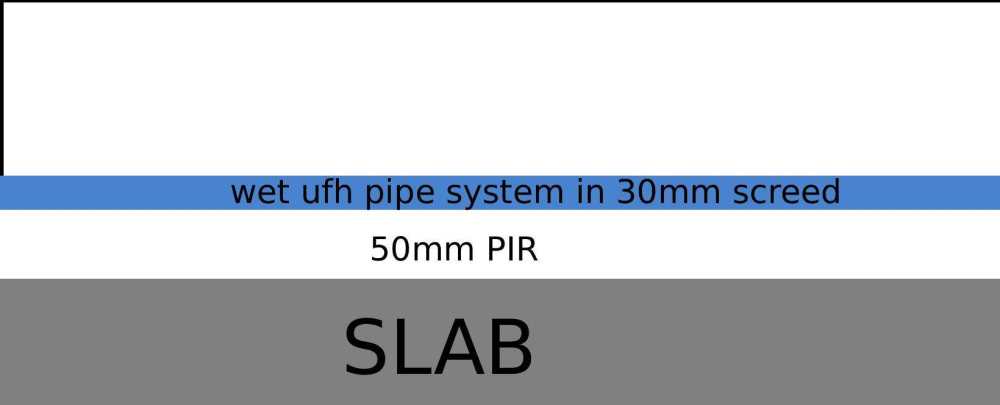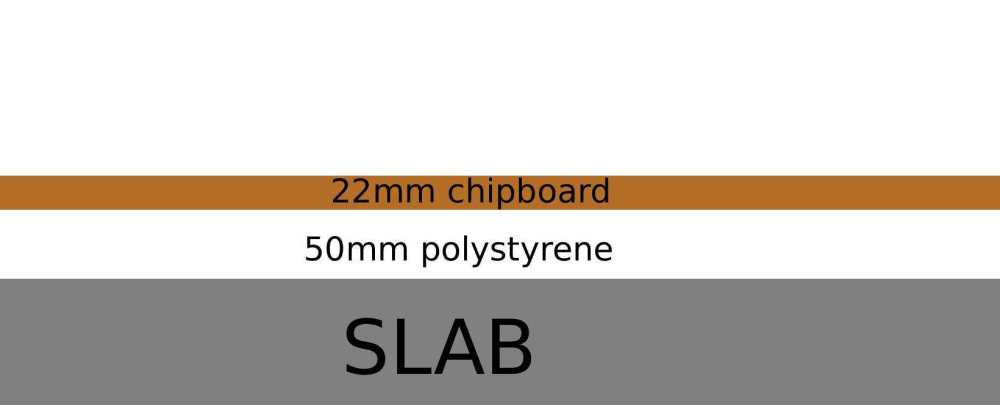
Workerbee
Members-
Posts
33 -
Joined
-
Last visited
Recent Profile Visitors
The recent visitors block is disabled and is not being shown to other users.
Workerbee's Achievements

Member (3/5)
2
Reputation
-
Thank you @Nestor - that's great. Really appreciate your and @Nickfromwalesinput, as I've been going around in circles! That's interesting - I'd aimed for about 10-15mm difference and add a threshold strip, but perhaps I should aim for less. If so, would 10mm insulated tile backer board work, screwed to battens? It would lower the height and at least add a little more insulation, although the screws would be thermal bridges. Or gypdeck 18, which is t&g. I'm not sure which electric ufh - yet another thing I need to research, so I'm open to recommendations!
-
Thank you for your help with this. My two worries about that would be the low amount of insulation for the electric ufh (xps a worse insulator and the self levelling eating into an already shallow buildup), and that when the ufh breaks, I'd need to cut into the tanking and self levelling, not just the tiles. Would the chipboard idea (either with battens, or without and bonded to the slab) definitely not work? I'd also looked at gypdeck 18, but it's expensive and presumably wouldn't connect into the 22mm bedroom chipboard.
-
Thank you both. It's a renovation that previously had 50mm polystyrene on the slab, topped with 22mm chipboard, so I don't feel I have much choice about it being floating. My thinking was that the battens would provide more stability for tiling. I would screw the battens to the slab, then screw the chipboard to the battens. I'd originally thought about XPS tile backer boards adhesively stuck to the slab, but manufacturers seemed to think tongue and groove was essential. Would there be a better way, do you think?
-
Hello - I was wondering if you'd be able to sense-check my floating floor plan, please? The wetroom is just a corner of the bedroom, about 3.7sqm. In the bedroom, I'll be putting 50mm PIR on the slab, topped with 22mm chipboard. For the wetroom floor, I therefore thought I'd do the same, then topped with impey waterguard, electric ufh, and natural stone. To help with stability on the floating floor, I thought I could add a perimeter of battens like in the picture below, and screw the chipboard into it: Does this sound like a plan? Thank you.
-
Hello! My floating floor research continues...I'd posted previously about options for wetroom and kitchen flooring and got some useful feedback. I've now got three options. It's an all-electric bungalow; bathroom is about 3.5sqm and kitchen about 20sqm. Old floor: concrete slab, then 50mm polystyrene, and 22mm t&g chipboard on top. I'm keeping the concrete slab. I'll add electric heating mats as a secondary heat to take the chill off the stone tiles. Option 1: 50mm PIR then 22mm chipboard. Basically, what was already there. Not sure about chipboard in a wetroom - would I have to cover it with 6mm tile backer board, which will add to the height? Option 2: Phenolic foam and gypdeck 18 gypsum fibre board. The best insulation (equivalent to 70mm PIR) but very expensive Option 3: 50mm PIR then a low profile wet system like this instead of boards: https://www.elementshop.co.uk/profix-plus-panel-low-profile-system-20mm-depth-14-17mm-pipe?gad_source=1&gad_campaignid=17190333812&gbraid=0AAAAAoLtzP8iYrR1bZmw5I1Nv6dekc2Bc&gclid=Cj0KCQiAoZDJBhC0ARIsAERP-F_Hahv5xh4NmuS9ME_vn1_shoXRaCY0TsHN_pwsQQTPzPKcmpZu_QkaAnxFEALw_wcB Together with electric ufh, this would futureproof me if I ever got a heat pump. Would this also give me some thermal mass if I heated the electric ufh on overnight offpeak? Are there any better options? Thanks!
-
Floating floors: compression vs vibration
Workerbee replied to Workerbee's topic in Floor Structures
I've continued my floating floor research for the wetroom and kitchen and I've come down to three options to put on top of the slab: - keep it simple and cheap with 50mm PIR topped with 22mm t&g chipboard. - 50-60mm phenolic topped with gypdeck 18. The gypdeck's lambda is 0.038, so if I squeezed in 60mm phenolic this buildup would be the equivalent of 80mm PIR. - 50-60mm PIR topped with a low profile screed system like this one: https://www.elementshop.co.uk/profix-plus-panel-low-profile-system-20mm-depth-14-17mm-pipe?gad_source=1&gad_campaignid=17190333812&gbraid=0AAAAAoLtzP8iYrR1bZmw5I1Nv6dekc2Bc&gclid=Cj0KCQiAoZDJBhC0ARIsAERP-F_Hahv5xh4NmuS9ME_vn1_shoXRaCY0TsHN_pwsQQTPzPKcmpZu_QkaAnxFEALw_wcB which would future proof me for a wet system, without raising the floor height Floor finish will be electric ufh then natural stone. Is the extra cost of the phenolic or gypdeck worth it, or would it not provide enough difference? Has anyone had experience with the gypdeck? Thank you -
Floating floors: compression vs vibration
Workerbee replied to Workerbee's topic in Floor Structures
Thank you for finding these @JohnMo - I'll have a look. -
Floating floors: compression vs vibration
Workerbee replied to Workerbee's topic in Floor Structures
Thank you very much for this, @JohnMo Yes you're right, I've had concerns about cost, but I feel I'm trying to find a balance with different factors. It's a bungalow, less than 50sqm. I'm adding 100-125mm PIR in the ceilings and 50mm on the walls. I'll be draft proofing and, although it'll never be ultra airtight, I'll add dmvhr instead of dmv. So hopefully it's a fairly small, fairly well insulated space to heat. A heat pump would be nice, but I can't really afford the cost up front. It's also a very quiet location, and after visiting several heat pumps I didn't feel it would be suitable. Also, with the size of the house, I don't know where I'd fit the extra equipment. Even a uvc is a headache (but I want the better flow rate vs an electric shower)! I have no wet system - it's an all electric house. The electric ufh is mainly just to take the chill off the floor, with a mind to it being used more in the future if I get batteries. Kitchen is about 16sqm, bathroom 4sqm. I also considered adding pipework for wet ufh in the kitchen as well as an electric mat, so it's ready to use if a more suitable system came to market in the future. Storage heaters would be a better idea than oil filled radiators; however, I've never found any that look particularly nice, so I'm a bit stuck. Thanks again -
Floating floors: compression vs vibration
Workerbee replied to Workerbee's topic in Floor Structures
Having spoken to a few technical departments, it sounds like compressive strength and 'vibration' (ie movement that could crack grout) are separate issues. Movement is caused by gaps due to each layer not being perfectly flat. Therefore I might as well use PIR/phenolic instead of XPS. Bonding the layers with pu foam will help with movement. In terms of what to put on top of the PIR: I was thinking xps tile backer board, as it adds more insulation and high rigidity. However, one technical department thought this might not work as it's not tongue and groove. Are they right? If so, and I need to use something with tongue and groove, is there anything offering better moisture resistance or thermal qualities than chipboard? Thanks! -
Floating floors: compression vs vibration
Workerbee replied to Workerbee's topic in Floor Structures
Thank you for the replies, and sorry for my poor explanation! It's a bungalow, and in terms of compressive strength I think any of polystyrene, PIR or XPS should be fine. I've done a crude drawing of what's currently there: The finish is currently carpet or tile. I'm basically just thinking of replacing the polystyrene with either PIR or XPS (ravatherm seems to have a decent lambda value), and replacing the chipboard with insulated tile backer board. This will mean I can bond everything together with suitable adhesive so that it's technically no longer floating, because the finish will be natural stone, which can obviously cause issues on a floating floor otherwise. I wondered if the ravatherm might have two benefits over PIR: would the fact it's not foil faced mean it bonds better? And more importantly does the higher compressive strength equate to lower vibration, or is that a separate characteristic? It's an all-electric house, so that's why I'm thinking of electric ufh. It'll probably be secondary heating, but given I'll be installing oil filled radiators it'll end up being just as expensive! Thanks again. -
Hello! I know floating floors have been discussed before, but I wanted to check my thinking with you guys before going ahead. I want to install natural stone and electric ufh on top of a floating floor in the kitchen and bathroom. Currently the buildup is concrete slab, then 50mm polystyrene, a vcl then 22mm t&g chipboard and carpet/stick-on vinyl tiles. Current ideas are: - 60mm ravatherm XPS, bonded to slab with approved adhesive, then 6mm insulated tile backer board. This would eliminate the floating floor as everything's bonded. XPS also has very high compressive strength; but does this also mean low vibration? - 50mm PIR or phenolic, then 10mm insulated tile backer board. Again, I could bond this with pu adhesive; it's only being squashed, so the fact it's foil faced shouldn't matter? - PIR/phenolic then insulated routed XPS boards for wet ufh pipework, then electric ufh mats above. I don't have gas, and heat pumps aren't currently suitable for my property, but this would give electric ufh now and the option for wet ufh should a suitable product come to market in the future. - if none of these is an improvement, then leave as is. So it's basically xps Vs PIR/phenolic: very high compressive strength vs better insulation. But does compressive strength mean low vibration for fitting stone? Can PIR be adhesive bonded to the slab? Thanks!
-
I'm looking at the direct, electric heated sunamp model as I'm an all electric house. So does this mean I was right in thinking the sunamp can't be 'overcharged' to increase its storage like a direct uvc can be? I'd been looking at the 210 version because I thought it would be overkill for two people; it's sometimes quoted for 6 person houses. But if my back-of-fag-packet sums were right, then even a 210 wouldn't be enough. Only an 'overcharged' - or at least above 55 degrees - uvc would do it, with the additional benefit of a second immersion if a boost was needed. As @SteamyTeasays, though, I'd need to check for thermal cutouts.
-
Thank you everyone - it's been very useful hearing your experiences and knowledge. I've continued my research (ie put off making a decision); leaving aside the customer service question for now, I've got a list of pros and cons for the Sunamp vs uvc, which I can post if it might be of use to anyone in future. But one thought occurred which might swing it decisively in the uvc's favour, and it's that you can 'overcharge' a uvc - ie increase the capacity by keeping it at a higher temperature, which you can't with the Sunamp. I'm thinking of the Sunamp eplus (direct) 210 - ie Sunamp say it's equivalent to a 212l cylinder. Mixed down to 40 degrees with an assumed 10 degree cold feed, it produces 301l according to the tech specs. (footnote: is this right? It would imply a temperature directly out of the Sunamp of only around 53 degrees). The only thing I need dhw for (other than hand washing) is a shower. My showers are about 8 mins, my partner about 14 mins. 22 mins total. Assuming a 12lpm shower, that's 22 * 12 = 264l. If I get a great shower experience at 15lpm, that's 22 * 15 = 330. Either way, it doesn't leave me much wriggle room. I would then be relying on a rapid recharge time with on-peak prices, and if we had guests, we're stuck. In winter, even more so. But with a 210l uvc, I could heat it above 70 degrees and get more water volume. Am I missing something?
-
How to approach this wetroom floor...
Workerbee replied to Workerbee's topic in Bathrooms, Ensuites & Wetrooms
Brilliant, thanks @Nickfromwales - that's a much better idea than mine! Is compressive strength related to vibration in a floating floor ie the higher the compressive strength of the insulation, the less risk of stone tiles failing? If so, whether I could go for something like Ravatherm XPS X 300 SL and then a layer of insulated backer boards over the top. Or whether it's simply the act of bonding the insulation to the slab that eliminates the floating floor, regardless of compressive strength. In that case, I could perhaps go for max insulation value with something like tissue faced phenolic boards. -
Thank you for that, @Russdl. Do you find the flow rate is as good as a uvc? Sunamp mentions main pressure hot water but nothing about flow rate, and I wondered if it might get restricted in order to maintain temperature, particularly when the incoming mains temperature drops in winter. I'm keen to have a decent shower experience!

.thumb.jpg.771e3f76b2f880806bd5eacf16a25a2b.jpg)



